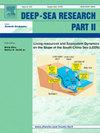Offshore demersal fish community structure and habitat associations in Amundsen Gulf, Canadian Arctic
IF 3
3区 地球科学
Q2 OCEANOGRAPHY
Deep-sea Research Part Ii-topical Studies in Oceanography
Pub Date : 2025-09-16
DOI:10.1016/j.dsr2.2025.105548
引用次数: 0
Abstract
Marine fishes occupy a range of trophic positions, all of which play integral roles in energy pathways within and amongst habitats. Understanding marine fish community structure and habitat associations is prerequisite to understanding ecosystem structure and function in the western Canadian Arctic, and the lack of regional-scale information impedes effective regulation of emerging industrial activities and climate adaptation strategies. Our study documented 46 demersal fish species from 29 genera, recording eight new species occurrences for Amundsen Gulf. The demersal fish community of Amundsen Gulf is largely structured by the depth-mediated water masses of the region where they interface with seafloor habitats. The fish assemblages appeared stable over the seven-year span of the study, while interannual fluctuations in abundance reflected species-level variability. Species richness was higher in Amundsen Gulf relative to the adjacent Canadian Beaufort Shelf and slope, but indexes for evenness and species dominance in Amundsen Gulf were skewed by the pervasiveness of Boreogadus saida. The average abundance of B. saida was 4.7 times higher at stations where fishing occurred within Atlantic waters relative to Pacific waters, with peak average abundance documented in Minto Inlet. The deep Atlantic water and large embayments of Amundsen Gulf support high abundances of B. saida across life-history stages and warrant special consideration for industrial planning and conservation initiatives. Our results provide contemporary baselines on marine fish community structure and diversity for the Amundsen Gulf region and provide a basis for evaluating future change and comparisons with neighboring regions.
加拿大北极阿蒙森湾近海底栖鱼类群落结构与生境关联
海洋鱼类占据着一系列的营养位置,所有这些都在栖息地内部和之间的能量途径中发挥着不可或缺的作用。了解海洋鱼类群落结构和栖息地关联是了解加拿大北极西部生态系统结构和功能的先决条件,缺乏区域尺度的信息阻碍了对新兴工业活动和气候适应战略的有效调控。我们的研究记录了来自29属的46种底栖鱼类,记录了阿蒙森湾出现的8个新物种。阿蒙森湾的底栖鱼类群落在很大程度上是由该地区的深水水体构成的,在那里它们与海底栖息地相连接。在研究的7年时间里,鱼类组合似乎很稳定,而丰度的年际波动反映了物种水平的可变性。阿蒙森湾的物种丰富度相对于邻近的加拿大波弗特陆架和斜坡较高,但均匀度和物种优势度指数受北海北岸的普遍影响而有所偏斜。在大西洋水域捕鱼的站点,相对于太平洋水域,B. saida的平均丰度高出4.7倍,记录的平均丰度峰值出现在Minto Inlet。大西洋深水和阿蒙森湾的大型海湾在整个生命史阶段都支持着丰富的白鲟,因此需要特别考虑工业规划和保护措施。我们的研究结果为阿蒙森湾地区的海洋鱼类群落结构和多样性提供了当代基线,并为评估未来变化和与邻近地区的比较提供了基础。
本文章由计算机程序翻译,如有差异,请以英文原文为准。
求助全文
约1分钟内获得全文
求助全文
来源期刊
CiteScore
6.40
自引率
16.70%
发文量
115
审稿时长
3 months
期刊介绍:
Deep-Sea Research Part II: Topical Studies in Oceanography publishes topical issues from the many international and interdisciplinary projects which are undertaken in oceanography. Besides these special issues from projects, the journal publishes collections of papers presented at conferences. The special issues regularly have electronic annexes of non-text material (numerical data, images, images, video, etc.) which are published with the special issues in ScienceDirect. Deep-Sea Research Part II was split off as a separate journal devoted to topical issues in 1993. Its companion journal Deep-Sea Research Part I: Oceanographic Research Papers, publishes the regular research papers in this area.

 求助内容:
求助内容: 应助结果提醒方式:
应助结果提醒方式:


